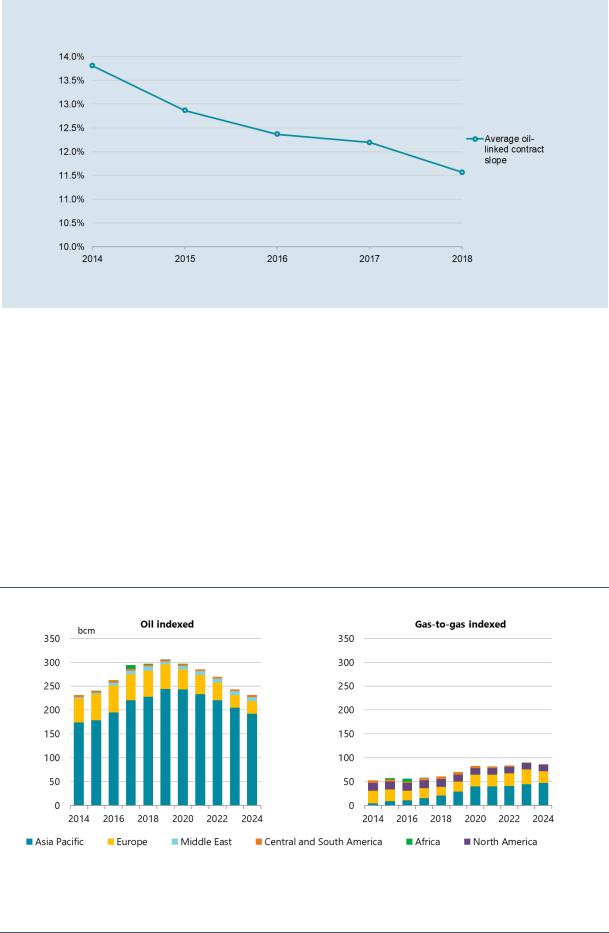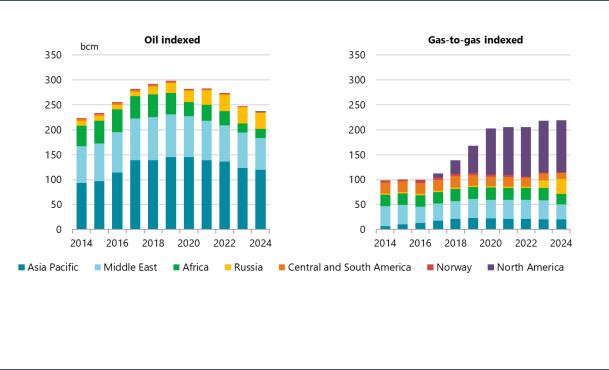
- •Abstract
- •Foreword
- •Executive summary
- •The drive for flexibility
- •Driven by portfolio players, LNG contracting activity rebounded to its highest level in five years…
- •… underpinned by longer, larger and more flexible contracts
- •Innovation in LNG contracting to enhance regional security of supply…
- •…means traditional buyers could become a larger source of additional flexibility for the Asian LNG market
- •The transformation of the broader energy system in north-western Europe…
- •…calls for the further enhancement of downstream gas flexibility
- •Findings and recommendations
- •Key findings
- •Update on LNG market flexibility metrics
- •LNG supply security in Asia: An opportunity for traditional buyers
- •North-western Europe’s gas flex: Still fit for purpose?
- •Technical analysis
- •1. Update on LNG market flexibility metrics
- •Introduction
- •Update on LNG contract trends
- •Liquefaction activity: New wave of investment gaining momentum
- •Export source and import destination: Flexible gas gaining ground
- •Longer and larger contracts do not mean less flexibility
- •Portfolio players and flexibility
- •Analysis of contract flexibility
- •Pricing trends
- •References
- •2. LNG supply security in Asia: An opportunity for traditional buyers?
- •Introduction
- •LNG flexibility in Asia
- •Flexibility in long-term contracts
- •Options in LNG contracts
- •Valuation of options
- •Flexibility in Japanese LNG contracting
- •Innovation in contracting
- •Expansion of LNG network
- •Creating joint ventures
- •Expanding LNG outlets
- •Proximity and security of supply
- •References
- •3. North-western Europe’s gas flex: Still fit for purpose?
- •Introduction
- •Gas flexibility toolkit
- •North-western Europe’s gas demand: Seasonality and volatility
- •Current state of flexibility tools
- •Upstream deliverability
- •Import capacity
- •Midstream interconnectivity
- •Storage capacity
- •A transforming energy system
- •References
- •General annex
- •Abbreviations and acronyms
- •Acknowledgements
- •Table of contents
- •List of figures
- •List of boxes
- •List of tables

Global Gas Security Review 2019 |
1. Update on LNG market flexibility metrics |
almost a third of total export capacity, with contracted fixed destination clauses falling to roughly onethird, and contracted flexible destination accounting for the final third.
As already highlighted, an important share of this increase in destination flexibility is market driven. The activity of portfolio players, which are increasingly serving a more fragmented buyer pool, required flexible conditions.
Although emerging markets with increasing demands continue to secure volumes, buyers from markets that traditionally look to fixed destination contracts (Japan and Korea, for example) have also been pushing for greater flexibility in new LNG contracts. Many competition authorities have adopted cautious attitude to this kind of clause, either fighting to remove them from existing contracts or preventing any seller from including them in new contracts. As explained in last year’s report, the Japan Fair Trade Commission, Korea Fair Trade Commission and European Commission have conducted several formal investigations into the legality of fixed destination contracts. Notably, these investigations explored whether traditional clauses included in supply contracts are anticompetitive and have the potential to violate national or regional antitrust laws.
While some competition authorities are more focused on avoiding fixed destination clauses in new contracts, the European Commission previously agreed to close its investigations once these clauses were erased from existing contracts and banned from the future contracting (e.g. Sonatrach investigation [European Commission, 2007]). Some of these inquiries have yet to conclude (IEA, 2018), complicating the task of anticipating the outcome and the implications for the LNG market. These authorities intend to continue monitoring the LNG market in order to protect the interests of their consumers.
Pricing trends
The price of LNG has traditionally been indexed to the price of crude oil (either international crude prices such as Brent or West Texas Intermediate, or specific crude import prices such as Japanese Customs-cleared Crude or “Japanese Crude Cocktail” [JCC]).
Box 1. Oil-linked contract slopes
A contract slope establishes the degree of oil-to-gas indexation. It measures the extent to which the LNG price changes in response to changes in the oil price. For example, a slope of 16.67% is approximately oil parity. LNG has typically been priced at this level unless markets are extremely tight, or the features of the deal or the buyer profile could imply a higher risk for the seller. Oil-linked pricing formulas usually also include upper and lower limits (S-curves), thereby dampening the impact that oil price changes could have on the LNG price. Setting aside S-curves and other mechanisms, buyers prefer a flat slope in a context of high oil prices since it limits the impact on the price they have to pay. LNG producers and sellers prefer flat slopes at low oil prices to minimise the impact on cash flows.
During 2018 and only for the contracts for which information is available, oil-linked contract price slopes remained mostly within the 11–12% range, continuing with the declining trend seen since 2014 (when the range was concentrated between 13% and 14%). Slope numbers are expected at least to remain within this range, as liquefaction capacity from Australia and the United States continues to come online until 2022 and additional liquefaction capacity has already taken FID.
PAGE | 30
IEA. All rights reserved.

Global Gas Security Review 2019 |
1. Update on LNG market flexibility metrics |
Average oil-linked contract slopes by signing year (2014–18)
Source: IEA analysis based on ICIS (2019), ICIS LNG Edge, https://lngedge.icis.com/ (subscription required).
Novel approaches to price linkages have started to gain momentum. Since the beginning of this decade, European gas contracts have increasingly been signed or renegotiated to include hub gas price indexation (even though this process has not been homogeneous among regions), reducing the historically predominant links to oil. Gas-to-gas indexation, preferably to liquid hubs, eliminates crosscommodity risk and aims to better mirror supply and demand fundamentals. However, lack of liquidity and price visibility on the physical market (and through associated derivative instruments) remain concerns.
The analysis of LNG contracts by price formula – addressing the split between oil-indexed and gas-to- gas pricing, by export and import, by region and country – shows a recent trend towards gas-to-gas indexation in both LNG export and import contracts since the first US LNG shipment in 2016. Gas hublinked LNG contracts (especially to Henry Hub, but also to the Title Transfer Facility [TTF] or the National Balancing Point [NBP]) are gaining a larger share of contracts signed than in previous years, not only in Europe but also in Asia. Over 75% of oil-indexed LNG is delivered to the Asia Pacific region, with Europe accounting for most of the rest (Figure 26).
Figure 26. Oil indexed vs gas-to-gas indexed import volume (2014–24)
Note: Contracts not linked to a specific destination/origin have been excluded from the analysis.
Source: IEA analysis based on ICIS (2019), ICIS LNG Edge, https://lngedge.icis.com/ (subscription required).
Recent import volumes slightly tend towards gas-to-gas indexation based on contracts signed in a variety of regions.
PAGE | 31
IEA. All rights reserved.

Global Gas Security Review 2019 |
1. Update on LNG market flexibility metrics |
This report expects a further decline in the share of the oil-indexed pricing in export contracts (Figure 27). The largest decrease in oil-indexed pricing is observed in the Africa region (down by 27 bcm between 2018 and 2024), followed by the Middle East (down by 23 bcm). The decreasing oilindexed volume is associated with the expiry of existing contracts gradually from 2017. The gas-to- gas pricing mechanism is mostly driven by Henry Hub-priced LNG exports from the United States. As the US export volume continues to rise with the growth in liquefaction capacity, gas-to-gas- priced LNG contracts from the United States are expected to account for more than 47% of all export contracts by 2024, up from less than 10% in 2017. These contracts are projected to become the dominant source of all gas-to-gas-priced import contracts in the Asia Pacific region.
Figure 27. Oil indexed vs gas-to-gas indexed export volume, 2014–24
Note: Contracts not linked to a specific destination/origin have been excluded from the analysis.
Source: IEA analysis based on ICIS (2019), ICIS LNG Edge, https://lngedge.icis.com/ (subscription required).
North American volumes represent 47% of gas-to-gas-priced export contract volumes by 2024, increasing from a share of only 10% in 2017.
The steady decline in oil-linked contracts can be explained by both customer preference and the approach taken by portfolio players. Emerging Asian importers, expected to be the main driver of LNG growth in coming years, secure gas-to-gas-indexed US LNG to diversify their procurement portfolio. At the same time, long-term oil-indexed contracts still provide their main supply of gas. Portfolio players diversify with US LNG under gas-to-gas-indexed contracts, but then resell some of those volumes under an oil-indexed pricing formula. In 2018, 70% of the volumes supplied by portfolio players were oil-indexed, while 80% of the contracts sourced for portfolio players were gas-to-gas indexed. With this, portfolio players are trying to avoid Henry Hub as the price reference for exporting since the price dynamics in the United States have no correlation to competing energy sources in their domestic market.
During 2018 and 2019, the diversification behaviour evolved further with the onset of new pricing structures based on the destination market and the use of the gas:
April 2019: Shell and Tokyo Gas announced the signing of heads of agreement partly using a coal-linked pricing formula, the first time this approach has been observed in LNG contracts. In addition to securing a long-term and stable supply, this deal is designed to maintain the competitiveness of gas against its main competitor in the power sector through a continuous benchmark against coal prices in the target market (Reuters, 2019).
PAGE | 32
IEA. All rights reserved.
Global Gas Security Review 2019 |
1. Update on LNG market flexibility metrics |
June 2019: Cheniere and Apache settled a long-term gas supply agreement, in which Apache will supply 1.16 bcm over the next 15 years to be marketed by Cheniere. The agreement uses an innovative LNG pricing structure based on international LNG indices, according to which Apache receives an LNG price net of a fixed liquefaction fee and additional costs incurred by Cheniere (Cheniere, 2019). In this price structuring system, the producer accepts international prices instead of relying on the Henry Hub price, whose dynamics are not totally aligned with LNG fundamentals (Bloomberg, 2019b).
July 2019: Tellurian and Total announced an SPA in which the purchase price at the liquefaction terminal is linked to a destination market price, based on the Platts Japan Korea Marker (LNG World News, 2019). This pricing structure could force the offtaker to pay a higher price, depending on the spot market, but it dramatically reduces the market risk Total assumes since the structure includes a built-in profit margin. This agreement is similar to an earlier nonbinding agreement that Tellurian signed with Vitol in 2018 (Platts, 2018; Reuters, 2018).
The growing availability of LNG is being facilitated by an increasing number of portfolio players and additional capacity due to come online in the coming years. The expansion of the market and new pricing structures have provided the opportunity for both sellers and buyers to adopt increased market flexibility, while also adapting to a more volatile environment.
References
Bloomberg (2019a), “Commodity traders turn to LNG as big oil profits prove elusive”, www.bloomberg.com/news/articles/2019-03-27/lng-grows-for-trading-houses-from-gunvor-to- trafigura-glencore.
Bloomberg (2019b), “America’s gas is hot in Shanghai. The price, not so much”, www.bloomberg.com/news/articles/2019-04-03/american-gas-is-hot-in-shanghai-american-prices-not- so-much.
Cheniere (2019), “Cheniere Corpus Christi Stage III and Apache sign long-term gas supply agreement indexed to global LNG prices”, https://chenierelng.gcs-web.com/node/20586/pdf.
European Commission (2007), “Commission and Algeria reach agreement on territorial restrictions and alternative clauses in gas supply contracts”, http://europa.eu/rapid/press-release_IP-07-1074_en.htm.
ICIS (2019), ICIS LNG Edge, https://lngedge.icis.com/ (accessed 23/08/2019) (subscription required).
IEA (International Energy Agency) (2019), Market Report Series: Gas 2019, IEA, Paris, https://webstore.iea.org/market-report-series-gas-2019.
IEA (2018), Global Gas Security Review 2018, IEA, Paris, https://webstore.iea.org/global-gas-security-review- 2018.
Ledesma, David and Mike Fulwood (2019), “New players, new models”, OIES, Oxford, www.oxfordenergy.org/wpcms/wp-content/uploads/2019/04/New-Players-New- Models.pdf?v=11aedd0e4327.
LNG World News (2019), “Total kicks up investment in Tellurian’s Driftwood LNG”, www.lngworldnews.com/total-kicks-up-investment-in-tellurians-driftwood-lng/.
Platts (2018), “Tellurian-Vitol LNG deal signals shifting balance of power”, https://blogs.platts.com/2018/12/11/tellurian-vitol-lng-deal-shifting-power/.
Reuters (2019), “Tokyo Gas, Shell sign LNG deal linked to coal pricing in rare move”, www.reuters.com/article/us-lng-tokyo-gas-shell/tokyo-gas-shell-sign-lng-deal-linked-to-coal-pricing-in- rare-move-idUSKCN1RH0UB.
Reuters (2018), “US LNG developer Tellurian strikes initial offtake deal with Vitol”, www.reuters.com/article/lng-usa-tellurian/u-s-lng-developer-tellurian-strikes-initial-offtake-deal-with- vitol-idUSL8N1YB53D.
PAGE | 33
IEA. All rights reserved.
